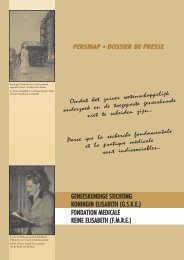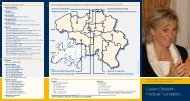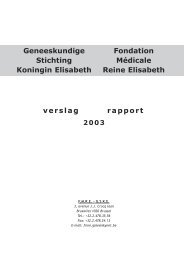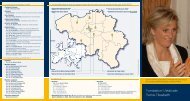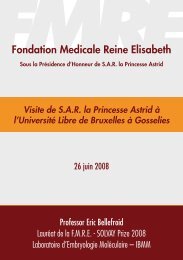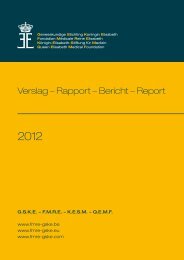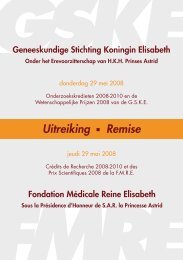Geneeskundige Stichting Koningin Elisabeth ... - GSKE - FMRE
Geneeskundige Stichting Koningin Elisabeth ... - GSKE - FMRE
Geneeskundige Stichting Koningin Elisabeth ... - GSKE - FMRE
You also want an ePaper? Increase the reach of your titles
YUMPU automatically turns print PDFs into web optimized ePapers that Google loves.
The role of presenilin-1 in the gamma-secretase cleavage of the amyloid precursor protein of Alzheimer's disease.<br />
Octave JN, Essalmani R, Tasiaux B, Menager J, Czech C, Mercken L. J Biol Chem. 275 (2000) 1525-1528.<br />
The most common causes of familial Alzheimer's disease are mutations in genes encoding<br />
presenilins (PS) 1 and 2. These mutations alter APP processing and cause increased production<br />
of the high amyloidogenic Aß 42. Moreover, PS1-deficient mice show decreased g-secretase<br />
processing of APP. PS are hydrophobic proteins that cross 6-8 times the membrane of the endoplasmic<br />
reticulum. A limited portion of PS undergoes endoproteolysis and the resulting N- and<br />
C-terminal fragments are localized predominantly in the Golgi. Presenilins are homologous to<br />
proteins involved in vesicle transport or in the Notch developmental pathway in the nematode<br />
Caenorhabditis elegans, and PS1-deficient mice show developmental abnormalities consistent<br />
with altered Notch signaling. Signaling through the receptor protein Notch requires ligand-induced<br />
cleavage of Notch. The recent demonstration that PS1 deficiency reduces the proteolytic<br />
release of the Notch intracellular domain indicates that PS1 regulates both APP processing and<br />
Notch signaling by influencing protein cleavage events. Since PS1 is required for both release<br />
of intracellular domain of Notch and γ-secretase cleavage of APP, it has been proposed that<br />
PS1 acts by facilitating the activity of the protease involved or is the protease itself. Human<br />
APP695 and PS1 were coexpressed in Sf9 insect cells, in which endogenous g-secretase activity<br />
is not detected. In baculovirus infected Sf9 cells, PS1 undergoes endoproteolysis and interacts<br />
with APP. However, PS1 does not cleave APP in Sf9 cells. In CHO cells, endocytosis of APP<br />
is required for Aß secretion. Deletion of the cytoplasmic sequence of APP (APPDC) inhibits both<br />
APP endocytosis and Aß production. When APP∆C and PS1 are coexpressed in CHO cells, Aß<br />
is secreted without endocytosis of APP. Taken together, these results conclusively show that,<br />
although PS1 does not cleave APP in Sf9 cells, PS1 allows the secretion of Aß without endocytosis<br />
of APP by CHO cells.<br />
103




